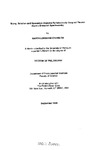Slurry, Solution and Speciation Analysis By Inductively Coupled Plasma Atomic Emission Spectrometry
| dc.contributor.author | O'HANLON, KAREN LORRAINE | |
| dc.contributor.other | School of Geography, Earth and Environmental Sciences | en_US |
| dc.date.accessioned | 2013-09-24T09:12:47Z | |
| dc.date.available | 2013-09-24T09:12:47Z | |
| dc.date.issued | 1996 | |
| dc.identifier | NOT AVAILABLE | en_US |
| dc.identifier.uri | http://hdl.handle.net/10026.1/1907 | |
| dc.description.abstract |
Inductively coupled plasma atomic emission spectrometry has been investigated for solution, slurry and speciation analysis. It has been shown that it is possible to optimise a simultaneous multielement analysis for slurry and solution samples using solid state detection and optimisation algorithms. A range of certified reference materials have been analysed using optimum conditions and results were in good agreement with certified values. Slurry nebulisation has been used for the first time in the analysis of NIST SRM Total Diet' and carbon black samples. Both radially and axially viewed ICP spectrometers were used in these studies. Modifications of the mass transport efficiency of solutions and slurries through the sample introduction system was illustrated upon EIE addition. The transport phenomenon was found to be dependent on the matrix element and not on the analyte of interest. A decrease in transport efficiency was found to be related to the mass of the EIE added. Solution and slurry atom and ion line intensity ratios obtained from an axially viewed ICP were used to illustrate emission enhancement when Mg was used as the thermometric species of interest. Enhancement was found to be spatially dependent and the energy transfer processes governing excitation were modified upon EIE addition. The magnitude of the enhancement effects for solutions and slurries differed, once transport effects had been negated, and this was attributed to variations in atomisation efficiency. A radially viewed ICP spectrometer was also used to monitor the effect of ElEs on solutions and slurries. The Abel integral technique was used to transform lateral profiles and Fe atom line ratios were calculated. 'Real' enhancement effects were apparent upon EIE addition when transport effects had again been negated. The plasma excitation temperature was used as a physical marker to determine the effect of EIE addition on solutions and slurries of Fe. The variation in Texc upon EIE addition was small but showed an increasing trend from Li to Cs. Radially obtained values of Texc were lower than literature values whereas preliminary values obtained axially compared well. It has been demonstrated that transient signal data may be obtained from an array-based spectrometer for speciation studies. The feasibility of reverse phase and size exclusion HPLC-ICP-AES has been demonstrated for the separation of a selection of organosilicon species of various molecular weights. Detection limits were in the range 0.1 to 5 ug ml-1 for a radially viewed plasma. The use of axial viewing when aspirating organic solvents as part of the mobile phase yields higher limits of detection owing to the noise that is measured. | en_US |
| dc.description.sponsorship | The Perkin-Elmer Corp. 761 Main Ave.. Nonwalk, CT 06897, USA | en_US |
| dc.language.iso | en | en_US |
| dc.publisher | University of Plymouth | en_US |
| dc.title | Slurry, Solution and Speciation Analysis By Inductively Coupled Plasma Atomic Emission Spectrometry | en_US |
| dc.type | Thesis | |
| plymouth.version | Full version | en_US |
| dc.identifier.doi | http://dx.doi.org/10.24382/4133 | |
| dc.identifier.doi | http://dx.doi.org/10.24382/4133 |
Files in this item
This item appears in the following Collection(s)
-
01 Research Theses Main Collection
Research Theses Main


